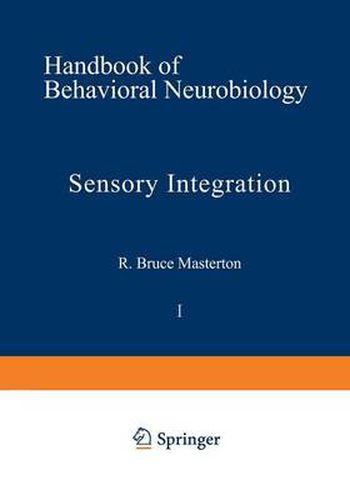Readings Newsletter
Become a Readings Member to make your shopping experience even easier.
Sign in or sign up for free!
You’re not far away from qualifying for FREE standard shipping within Australia
You’ve qualified for FREE standard shipping within Australia
The cart is loading…






This title is printed to order. This book may have been self-published. If so, we cannot guarantee the quality of the content. In the main most books will have gone through the editing process however some may not. We therefore suggest that you be aware of this before ordering this book. If in doubt check either the author or publisher’s details as we are unable to accept any returns unless they are faulty. Please contact us if you have any questions.
The principal goal of the Handbook of Behavioral Neurobiology is a systematic, critical, and timely exposition of those aspects of neuroscience that have direct and immediate bearing on overt behavior. In this first volume, subtitled Sensory Integration, the subject matter has been subdivided and the authors selected with this particular goal in mind. Although the early chapters (on the phylogeny and ontogeny of sensory systems, and on the common properties of sensory systems) are somewhat too abstract to permit many direct behavioral inferences, the focus on behavior has been maintained there too as closely as is now possible. A behavioral orientation is most obvious in the remaining chapters, which layout for each sensory modality in turn what is now known about structure-behavior relationships. The handbook is primarily intended to serve as a ready reference for two types of readers: first, practicing neuroscientists looking for a concise and authori tative treatment of developments outside of their particular specialities; and second, students of one or another branch of neuroscience who need an overview of the persistent questions and current problems surrounding the relation of the perceptual systems to behavior. The requirements imposed by the decision to address these particular audiences are reflected in the scope and style of the chapters as well as in their content.
$9.00 standard shipping within Australia
FREE standard shipping within Australia for orders over $100.00
Express & International shipping calculated at checkout
This title is printed to order. This book may have been self-published. If so, we cannot guarantee the quality of the content. In the main most books will have gone through the editing process however some may not. We therefore suggest that you be aware of this before ordering this book. If in doubt check either the author or publisher’s details as we are unable to accept any returns unless they are faulty. Please contact us if you have any questions.
The principal goal of the Handbook of Behavioral Neurobiology is a systematic, critical, and timely exposition of those aspects of neuroscience that have direct and immediate bearing on overt behavior. In this first volume, subtitled Sensory Integration, the subject matter has been subdivided and the authors selected with this particular goal in mind. Although the early chapters (on the phylogeny and ontogeny of sensory systems, and on the common properties of sensory systems) are somewhat too abstract to permit many direct behavioral inferences, the focus on behavior has been maintained there too as closely as is now possible. A behavioral orientation is most obvious in the remaining chapters, which layout for each sensory modality in turn what is now known about structure-behavior relationships. The handbook is primarily intended to serve as a ready reference for two types of readers: first, practicing neuroscientists looking for a concise and authori tative treatment of developments outside of their particular specialities; and second, students of one or another branch of neuroscience who need an overview of the persistent questions and current problems surrounding the relation of the perceptual systems to behavior. The requirements imposed by the decision to address these particular audiences are reflected in the scope and style of the chapters as well as in their content.